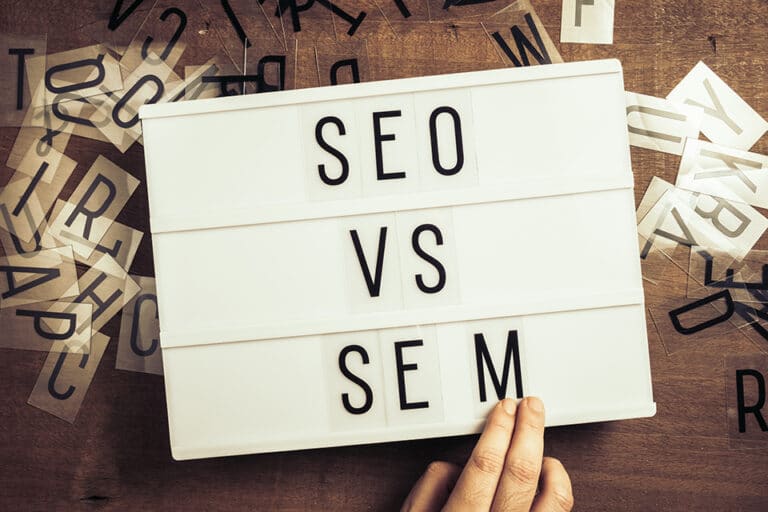Want to drive traffic to your site through the use of digital marketing? Trying to understand what the differences between SEO and SEM are?
If you want to boost your online presence and get results for your business, the right digital marketing strategies can help. One difficult thing to understand when building your digital marketing strategy, however, is the difference between SEO and SEM. These two terms are often used interchangeably, but they aren’t the same thing.
Fortunately, we’re here to clear it up for you. In this article, we’ll tell you about the difference between SEO and SEM.
The Basics of SEO and SEM
SEO and SEM are two terms that are often confused by newbie marketers, and while they may have some overlap, they aren’t the same.
Search engine optimization (SEO) refers to boosting your site in organic search results. It will consist of optimizing your site so that it will rank higher in Google and other search engines in a natural way.
Search engine marketing (SEM), on the other hand, refers to paid search advertising. This mostly consists of using pay-per-click (PPC) ads in which you pay directly for your ad copy to be shown online and to get more website visitors. Google Ads is one of the most popular online advertising platforms, but there are others as well.
With both types of marketing, it’s essential to optimize and tweak your strategy as time goes on. You’ll also need to perform keyword research and optimize copy to ensure your website pages or ads are targeting the right people.
Getting the Full Picture
Still not sure whether is SEO or SEM is right for you and what the differences are? Let’s go a little deeper so you can get a better understanding of both.
How SEO Works
When using SEO techniques, you’ll be optimizing your website to maximize its value in the eyes of search engines and to make it easier for search engine crawlers to understand. Unlike with paid search methods, you’ll be aiming to get natural, organic traffic from search engines which you won’t have to directly pay to receive.
With SEO techniques, you’ll be improving your site and making it more relevant to searchers. Once Google and other search engines recognize the relevance and value of your site’s pages they’ll start to send more and more traffic your way.
Multiple Types of SEO
When talking about SEO, it’s important to realize that there are multiple types. The main types include on-page SEO and off-page SEO. Here’s an overview of each:
- On-Page SEO: Any actions you take to optimize elements on your own website. This could include improving meta tags, content, page speed, site functionality, and internal link building.
- Off-Page SEO: Any actions you take to improve SEO factors outside of your own website. This includes getting backlinks and local citations from external websites. It also includes building social proof and boosting social signals.
Search engine algorithms are not static and change often as Google continues to roll out new updates on a regular basis. This means that if you’re interested in improving your site’s SEO, you’ll need to stay aware of the changes and adjust your strategy as needed.
SEO is a great digital marketing strategy for a business because it allows traffic to come to your site in a natural way. A well-optimized page may continue getting traffic for a long time to come once it starts ranking, without any extra effort on the part of the website owner. This means that SEO can potentially be very cost-effective and can be a good strategy for getting more traffic in the long term.
How SEM Works
SEM, at one time, was an umbrella term that refers to both SEO and PPC ads. These days, however, SEM strategies tend to be synonymous with PPC ads and other paid advertising efforts.
There are many different paid ad platforms, and although Google Ads are the most popular option for advertisers, Bing and Yahoo also have advertising platforms as well. Each of these can be used to great effect when marketing a business online, and if done right, can lead to more purchases and conversions.
Using SEM will primarily consist of optimizing ad campaigns. Some of the main actions will include launching ad campaigns, perfecting targeting features, optimizing ad copy, and choosing which keywords to use to reach a particular type of buyer or website visitor.
While SEO will work in a natural way to get free search traffic, SEM and PPC advertising will require advertisers to continue paying in order to keep ads running. The benefits, however, are that PPC ads launch instantly. They can also be very cost-effective, especially if tweaked to perfection over time.
Making the Choice Between SEO and SEM
So now that you know about the basics of SEO and SEM, you may be wondering which one is the best. Unfortunately, the answer isn’t a simple one. Both SEO and SEM have their advantages and disadvantages, and the one you use will be dependent on your goals.
If you want to build long-term, natural traffic that doesn’t require constant spending, SEO can be a great choice. SEO is a long-term strategy, and once you take action to improve it, the results will continue coming for a long time to come. On the negative side, it takes time to get the ball rolling with SEO, and it may take significant effort before you see results.
SEM, on the other hand, is a great option if you want to get results immediately. If you have a time-specific offer to promote, then paid ads can be beneficial. If tweaked to perfection, paid advertising can get your business some great results and can offer a great ROI.
However, unlike SEO you’ll only get the results you pay for. If you stop paying, the results will immediately stop coming.
While you’ll need to think about your specific goals when deciding whether SEO or SEM is right for you, the above is a good general overview. If in doubt, it’s often better to focus on SEO, since the results will be long-term. However, great businesses often use both of these together for different purposes.
Final Thoughts
If you want to boost your business online and form a great digital marketing strategy, it’s important that you consider the differences between SEO and SEM. Choosing the right one to focus on, or using them both together, will help you bring your business success when trying to get customers and clients online.
Searching for help with your digital marketing efforts? Get in touch now to learn more about how Infront Webworks can help you succeed.

Matthew is the President of Infront Webworks and is a New England native now calling Colorado Springs home. Matt attended The University of NH where he pursued a BS in Natural Resource Economics & Business Administration. Aside from Infront; Matthew has owned and managed two other online agencies based on the seacoast of New Hampshire and been a key player in multiple technology mergers & acquisitions. When he’s not bathing in technology, online marketing & business; he’s probably spending time with his wife and daughter, boating, skiing the trees, hiking or cooking..he is a foodie for sure!



